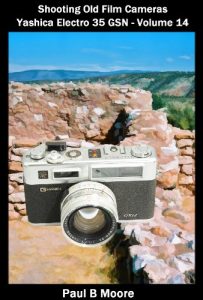Approximately 78 pages with about 75 color images and is ENTIRELY pictorial.
There is considerable debate among photographers about whether film is better than digital with about an equal number lining up on both sides and presenting their opinions and relevant and irrelevant data. It is not the purpose of this volume to espouse one position or another. It is sufficient to know that they are each different and subject to a considerable range of interpretation.
However, it is quite enjoyable to take one of these old cameras, that have absolutely no automatic functionality, and create excellent images. I suspect that it is the same force that drives auto enthusiasts to take an old Model T Ford car and restore it. They certainly don't have the power and ease of operation of modern automobiles but they are extraordinarily fun to drive!
Unlike other books about old cameras this one does not dwell on the fine technicalities of the individual camera (although limited technical data is present) but to present images taken with each camera to show the reader concrete examples of images taken with each model. All the images were taken at the Tuzigoot National Monument, home of the ancient Sinagua native American people, and at the ghost town near Jerome Arizona.
The Yashica Electro 35 GSN is a rangefinder type 35MM camera featuring an automatic shutter speed when the f stop is set which is coupled with the internal light meter. The camera was produced from 1973 through 1977.
The author began photography and photo-journalism in early 1963 when he accepted an offer from his local newspaper to write about and photograph sports events at the Arizona high school where he was a junior. After a stint in the service, he had an opportunity to study photography and printing techniques with Bernard Hoffman, a true gentleman and scholar, and one of the earliest staff photographers for Life Magazine.
Since that time he has had thousands of photographs and hundreds of articles published by more than 60 national and international periodicals. He was also a contributing editor for one of them for more than ten years. Topics ran the gamut from professional sports, medicine, archeology, and photography to science.
After twenty years away from Arizona he returned in 1985 and it has been the base from which all his photographic excursions are launched. Along with many others he has embraced digital photography but can still be seen, from time to time, peering through the ground glass of a large format camera, hoisting a large medium format 6x7, or indeed still using a 35mm film camera.
The photographer currently has fine art photography on exhibit at The Center for Fine Arts in Globe, Arizona, and is currently represented by more than ten stock photo agencies where he has more than 13,000 photographs available for commercial use.
There is considerable debate among photographers about whether film is better than digital with about an equal number lining up on both sides and presenting their opinions and relevant and irrelevant data. It is not the purpose of this volume to espouse one position or another. It is sufficient to know that they are each different and subject to a considerable range of interpretation.
However, it is quite enjoyable to take one of these old cameras, that have absolutely no automatic functionality, and create excellent images. I suspect that it is the same force that drives auto enthusiasts to take an old Model T Ford car and restore it. They certainly don't have the power and ease of operation of modern automobiles but they are extraordinarily fun to drive!
Unlike other books about old cameras this one does not dwell on the fine technicalities of the individual camera (although limited technical data is present) but to present images taken with each camera to show the reader concrete examples of images taken with each model. All the images were taken at the Tuzigoot National Monument, home of the ancient Sinagua native American people, and at the ghost town near Jerome Arizona.
The Yashica Electro 35 GSN is a rangefinder type 35MM camera featuring an automatic shutter speed when the f stop is set which is coupled with the internal light meter. The camera was produced from 1973 through 1977.
The author began photography and photo-journalism in early 1963 when he accepted an offer from his local newspaper to write about and photograph sports events at the Arizona high school where he was a junior. After a stint in the service, he had an opportunity to study photography and printing techniques with Bernard Hoffman, a true gentleman and scholar, and one of the earliest staff photographers for Life Magazine.
Since that time he has had thousands of photographs and hundreds of articles published by more than 60 national and international periodicals. He was also a contributing editor for one of them for more than ten years. Topics ran the gamut from professional sports, medicine, archeology, and photography to science.
After twenty years away from Arizona he returned in 1985 and it has been the base from which all his photographic excursions are launched. Along with many others he has embraced digital photography but can still be seen, from time to time, peering through the ground glass of a large format camera, hoisting a large medium format 6x7, or indeed still using a 35mm film camera.
The photographer currently has fine art photography on exhibit at The Center for Fine Arts in Globe, Arizona, and is currently represented by more than ten stock photo agencies where he has more than 13,000 photographs available for commercial use.






